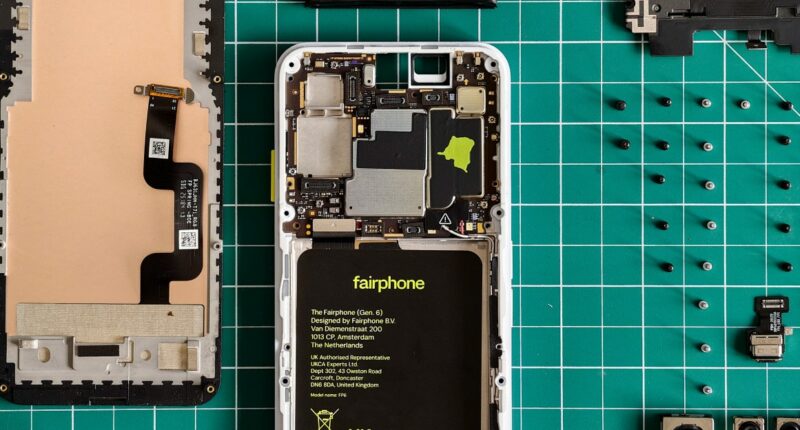Share this @internewscast.com
The Fairphone 6 makes its debut nearly two years after the Fairphone 5, reflecting the company’s unique perspective on upgrading. Ideally, Fairphone aims for its products to be durable, repairable, and long-lasting, hoping users won’t feel the need to upgrade so frequently.
This latest model maintains Fairphone’s dedication to repairability, long-term support, and ethical manufacturing practices. While opting for this phone means settling for less advanced technology and aesthetics compared to other brands, this year’s trade-offs are minor, with the phone’s eco-friendly credentials becoming increasingly significant.


$899
The Good
- Exceptionally user-repairable
- Ethically produced
- Decent performance
- Long-term software support
The Bad
- Basic cameras
- Only IP55
- Expensive in the US
Now available in the UK and Europe, the Fairphone 6 is priced at €599 / £499 with Fairphone’s custom Android, resembling a near-stock experience, or for €50 / £50 more, the privacy-centered /e/OS, crafted by Murena. In the US, only the latter version is sold, priced at $899 due to import tariffs, placing it in direct competition with flagship models rather than midrangers.

I’ve been using the version with /e/OS, which, although similar to stock Android visually, offers a distinct experience that emphasizes privacy. Features include quick settings for blocking app tracking cookies, falsifying location data, and concealing your IP address, alongside a feature that ranks apps based on tracking attempts. Murena calls this “de-Googled,” meaning it’s AOSP-based, doesn’t require Google accounts, comes without Google apps, and prevents data sharing with Google.
If you’re committed to a Google-free lifestyle, the phone comes with straightforward classic apps like calendar and maps, reminiscent of older designs. Its app store defaults to open-source apps and provides privacy ratings, detailing the trackers and permissions involved.

The store allows the installation of nearly all Android apps, including Google’s, if desired, via microG, an open-source substitute for Google Play Services. However, Google Wallet isn’t compatible for NFC payments, and some apps have stability issues, like MyFitnessPal, which won’t function, and a few others that may freeze and crash.
On the hardware side, the Fairphone 6 is smaller and lighter than the 5, with a brighter and smoother 6.31-inch 120Hz display. The Qualcomm Snapdragon 7s Gen 3 chipset isn’t flagship hardware, but it’s smooth enough most of the time, and with 8GB of RAM, it’s powerful enough for anything except serious gaming. The 4,415mAh battery lasts more than a day, and the 30W wired charging speed is fine but unimpressive, with no wireless option.
The cameras remain a big downgrade compared to the competition. The 50-megapixel main lens and 13-megapixel ultrawide are fine for the basics — and exceeded my expectations every now and then — but they struggle in the dark, in complex lighting, or with fast-moving subjects. If you just need your phone camera to be good enough then these definitely are, but you can get much better cameras for the same money (or less) elsewhere.
1/13
The other big addition to the Fairphone 6 is a range of semi-modular accessories, similar to those offered with Nothing’s CMF Phone 2 Pro. There’s a lanyard, a card holder, and a loop grip, but the clever thing is that all three screw onto the phone’s rear, becoming integral parts of the hardware. I hope more options are coming.
More important is the phone’s ability to last for years. Whether you buy from Fairphone or Murena, you’ll get an extended five-year warranty. Fairphone also commits to eight years of software updates and seven Android version updates, though Murena only promises five years of software support for its version — worse than the likes of Apple, Google, and Samsung.



The phone is made from fairly sturdy plastic, with Corning Gorilla Glass 7i on the display, and feels tough. There’s one big durability downside, though: it only has an IP55 rating for dust and water protection — good, but not great — which is the drawback of a repairable design that swaps glue for less watertight screws. So while the Fairphone 6 is more repairable than other alternatives, there’s a slightly higher risk of needing that repair in the first place, at least when it comes to sand and water.
Speaking of: you only need a single Torx T5 screwdriver to strip the phone down to parts, which connect and disconnect with a simple push, clicking into place. You can replace the battery, display, rear cover, each individual camera lens, speaker, earpiece, USB-C port, and SIM tray (which doubles as a microSD slot for expandable storage). Spare parts are sold by Fairphone and iFixit, with a promise to stock them for years. In the US, Murena should stock them, but at the time of writing, the parts aren’t on its site yet.




I wanted to confirm if any idiot could pull off a repair, so I took apart every bit of the phone I could and put it back together again, which took a little over an hour and left me with a perfectly functional phone on the other side. Fairphone has some good YouTube videos to run through any given repair step by step, and it couldn’t be much easier, so long as you pay attention to screwing everything back in the right order (ahem, not a mistake I’d ever make…).
The “fair” bit of the name applies to production too. Fairphone claims to use as many recycled materials as possible, and to work with mines, recyclers, component factories, and assembly lines with fair working conditions, from living wages to worker representation. There’s no ethical consumption under capitalism, but Fairphone claims to get as close as it can.
I’ve been cautious to recommend previous Fairphones. The elevator pitch is great, but paying a premium for underpowered hardware is still a hard sell. But pure power isn’t the differentiating factor it once was, so even if the Fairphone 6 is less powerful than its counterparts, it’s still powerful enough for most of us. Still, improvements in software support and durability from other manufacturers have made Fairphone’s offering less unique — though no one offers repairability like this.
Up against midrange alternatives, as it’s priced in Europe, the Fairphone holds its own. There are small compromises, but it remains a fair choice for just about anyone. In the US, where it costs more than some flagships and comes with the de-Googled /e/OS whether you like it or not, it’s only for those truly committed to the cause.
Photography by Dominic Preston / The Verge
16 Comments








